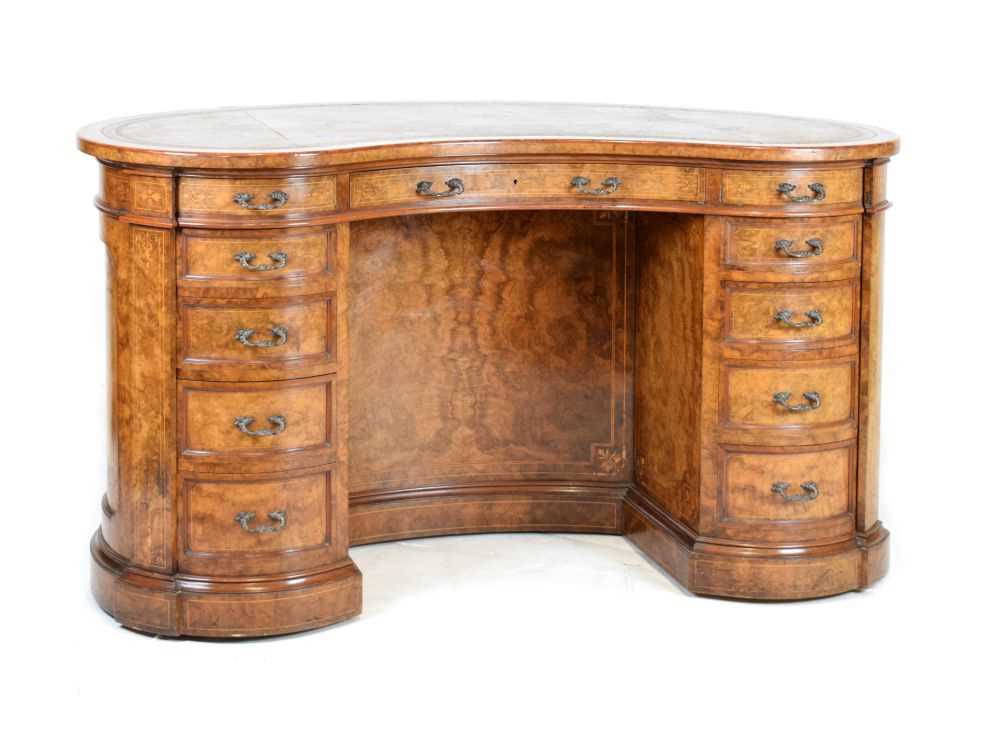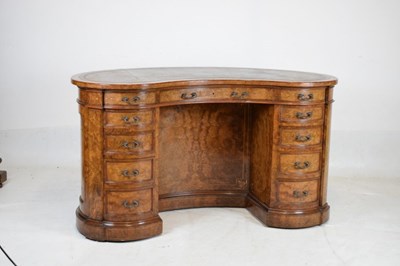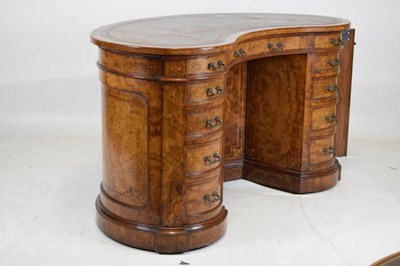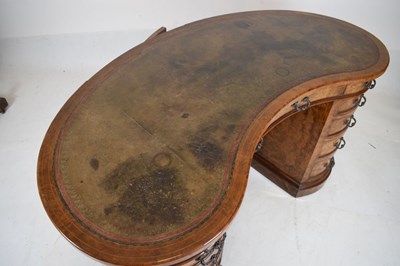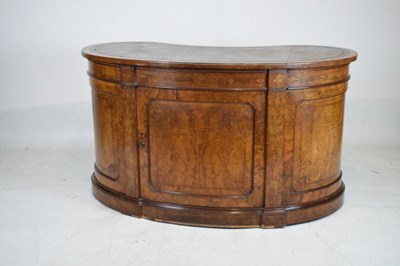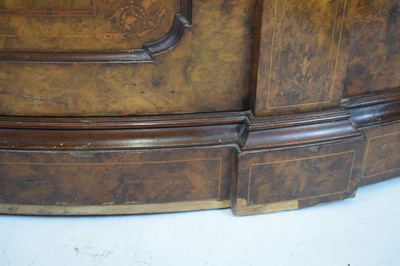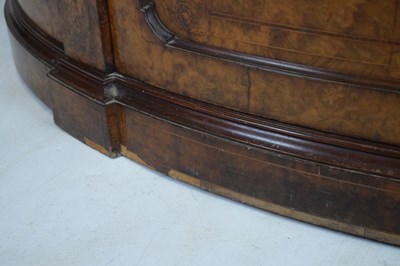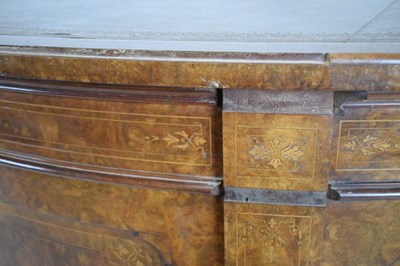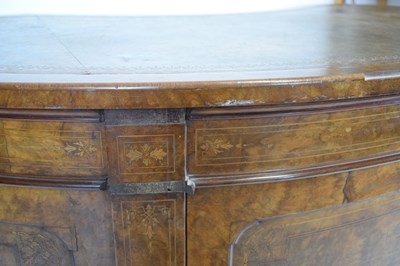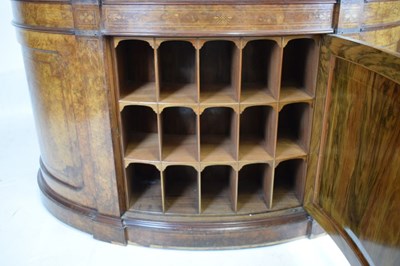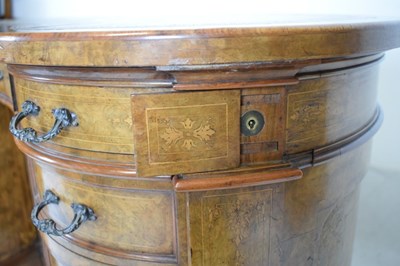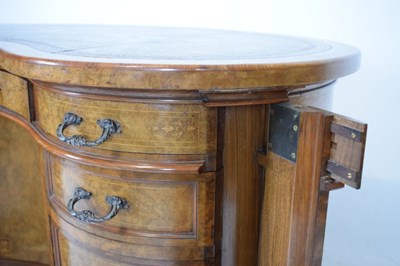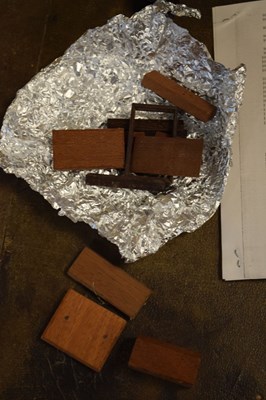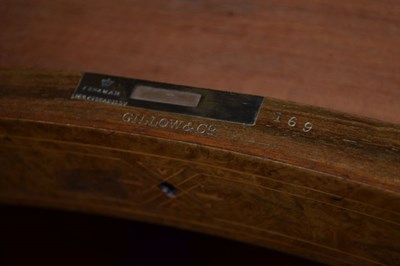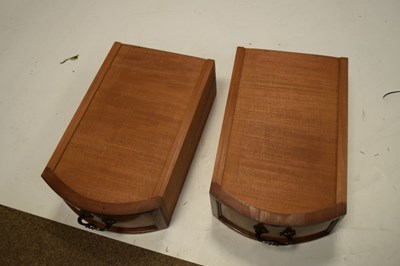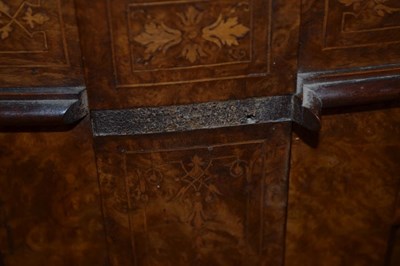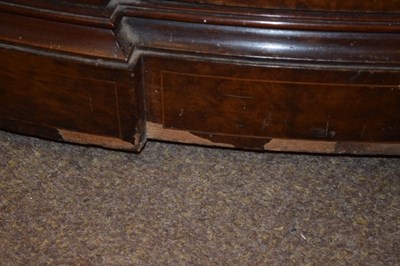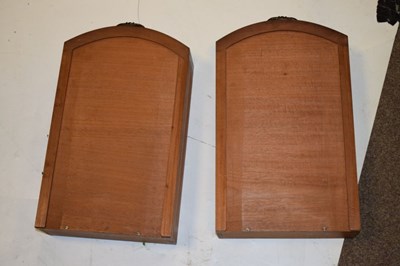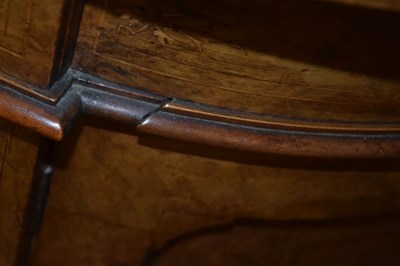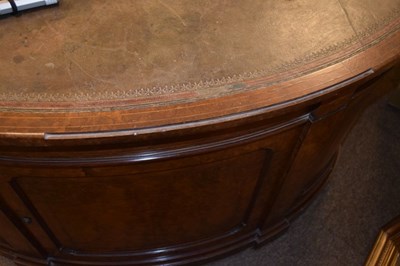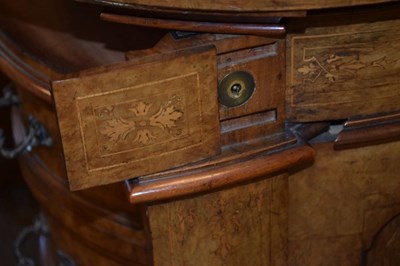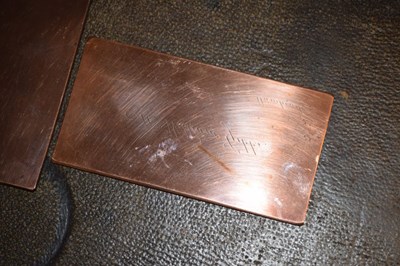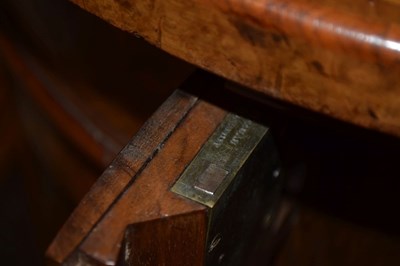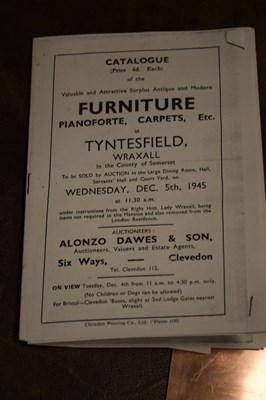10th Jun, 2021 10:30
Quarterly Specialist Sale
Fine Victorian burr walnut kidney-shaped pedestal desk by Gillow & Co
Gillow & Co., Lancaster and London - Fine Victorian burr walnut and inlaid kidney-shaped pedestal desk by Gillow and Co., Lancaster and London, the shaped top inset with a three-section red and gilt tooled green leather writing surface, above a frieze drawer flanked by two banks of five graduated drawers fitted patinated bronze cast rocaille handles, with hinged upright stiles fitted Bramah locks, the reverse unusually fitted with shaped panel door enclosing four tiers of five pigeon holes, on a moulded plinth base with concealed castors, stamped to the central drawer GILLOW & CO 169. The locks throughout are stamped J Bramah 124 Piccadilly and are with keys, 131cm wide x 74cm high x 66cm deep.
Supplied to William and Matilda Blanche Gibbs, for their London residence at 16 Hyde Park Gardens, and by descent at Tyntesfield , from where sold under the instructions of Ursula, Lady Wraxall, December 5th 1945 by Alonzo Dawes & Son (Clevedon Salerooms’ former name), Lot number 155 " Fine Inlaid Sheraton Kidney Writing Table with leather top, 11 drawers to lock and cupboard to back". Thence by descent.
Photocopy of original catalogue available to purchaser.
Although this form of desk has been ascribed to a design published by Thomas Sheraton in The Cabinet-Maker and Upholsterer's Drawing Book, London 1802, pl.58, it actually first appeared as a Gillow design a decade earlier in 1792 (Estimate Sketch Book 344/96, p. 896, September 1792. It was generally commercially produced by Gillow circa 1840-60 and references a second design in the Gillow Estimate Sketch book (1840) for An Oak Pedestal and Kidney Table supplied to Ferguson & Co.
This elegant desk was commissioned by William Gibbs, at the time the wealthiest commoner in the country, for 16 Hyde Park Gardens in London. History remembers Gibbs and his wife Matilda Blanche as the aggrandisers of Tyntesfield, the lavish Gothic Revival country house near Clevedon, now in the care of the National Trust. However, the couples’ principal residence was always their house in London, with Tyntesfield used more as a country retreat. The family moved from Hyde Park Street to Gloucester Place in 1849, and to the more substantial Hyde Park Gardens in 1851. This large house, in one of the capital’s most fashionable areas, was arranged over five floors with a fine sequence of rooms on the first floor, enjoying views of Hyde Park and glimpses of Paxton’s recently completed Crystal Palace.
In 1854 the Gibbs sought the advice of John Gregory Crace (1809-89) over the redecoration of Hyde Park Gardens. The firm of Crace & Sons were the pre-eminent decorators of the 19th century. At the time of his commission from Gibbs, J G Crace’s most recent clients had included the Duke of Devonshire at Chatsworth and, most famously, the interior of the rebuilt Palace of Westminster, which the firm had undertaken in partnership with A W N Pugin. The success of Crace’s work at Hyde Park Gardens led directly to Gibbs commissioning him to undertake the remodelling of the principal interiors of his country seat at Tyntesfield, where Crace’s work has been described as beginning a process by which the house was “reinvented as one of the foremost examples of Victorian Gothic design”. Crace’s success stemmed from his skill at re-interpreting historic styles, together with his mastery of surface decoration, talents which chimed perfectly with mid-19th century fashion. With this in mind, the inlaid decoration on this desk is noteworthy. Most known examples of this model do not incorporate such complex decorative inlay – relying instead on the richness of the wood alone. It is highly likely that this detail was introduced to harmonise with J G Crace’s interior.
Gillow’s enjoyed significant patronage from William Gibbs, as the discovery by the National Trust of a magnificent ‘Jacobethan’ table in the cellars at Tyntesfield has shown. This desk deserves to be seen in the context of the Gibbs’ role as significant patrons of the Victorian era as well as a testament to the extraordinary quality of Gillow craftsmanship.
As a footnote, when surveying the desk for this auction, two small Victorian copper nameplates for William and Matilda Blanche were found secreted behind the central frieze drawer, in pristine condition having almost certainly remained undisturbed for over a century. A charming discovery which underlines the intimate character of this outstanding piece of furniture.
Sold for £13,000
Gillow & Co., Lancaster and London - Fine Victorian burr walnut and inlaid kidney-shaped pedestal desk by Gillow and Co., Lancaster and London, the shaped top inset with a three-section red and gilt tooled green leather writing surface, above a frieze drawer flanked by two banks of five graduated drawers fitted patinated bronze cast rocaille handles, with hinged upright stiles fitted Bramah locks, the reverse unusually fitted with shaped panel door enclosing four tiers of five pigeon holes, on a moulded plinth base with concealed castors, stamped to the central drawer GILLOW & CO 169. The locks throughout are stamped J Bramah 124 Piccadilly and are with keys, 131cm wide x 74cm high x 66cm deep.
Supplied to William and Matilda Blanche Gibbs, for their London residence at 16 Hyde Park Gardens, and by descent at Tyntesfield , from where sold under the instructions of Ursula, Lady Wraxall, December 5th 1945 by Alonzo Dawes & Son (Clevedon Salerooms’ former name), Lot number 155 " Fine Inlaid Sheraton Kidney Writing Table with leather top, 11 drawers to lock and cupboard to back". Thence by descent.
Photocopy of original catalogue available to purchaser.
Although this form of desk has been ascribed to a design published by Thomas Sheraton in The Cabinet-Maker and Upholsterer's Drawing Book, London 1802, pl.58, it actually first appeared as a Gillow design a decade earlier in 1792 (Estimate Sketch Book 344/96, p. 896, September 1792. It was generally commercially produced by Gillow circa 1840-60 and references a second design in the Gillow Estimate Sketch book (1840) for An Oak Pedestal and Kidney Table supplied to Ferguson & Co.
This elegant desk was commissioned by William Gibbs, at the time the wealthiest commoner in the country, for 16 Hyde Park Gardens in London. History remembers Gibbs and his wife Matilda Blanche as the aggrandisers of Tyntesfield, the lavish Gothic Revival country house near Clevedon, now in the care of the National Trust. However, the couples’ principal residence was always their house in London, with Tyntesfield used more as a country retreat. The family moved from Hyde Park Street to Gloucester Place in 1849, and to the more substantial Hyde Park Gardens in 1851. This large house, in one of the capital’s most fashionable areas, was arranged over five floors with a fine sequence of rooms on the first floor, enjoying views of Hyde Park and glimpses of Paxton’s recently completed Crystal Palace.
In 1854 the Gibbs sought the advice of John Gregory Crace (1809-89) over the redecoration of Hyde Park Gardens. The firm of Crace & Sons were the pre-eminent decorators of the 19th century. At the time of his commission from Gibbs, J G Crace’s most recent clients had included the Duke of Devonshire at Chatsworth and, most famously, the interior of the rebuilt Palace of Westminster, which the firm had undertaken in partnership with A W N Pugin. The success of Crace’s work at Hyde Park Gardens led directly to Gibbs commissioning him to undertake the remodelling of the principal interiors of his country seat at Tyntesfield, where Crace’s work has been described as beginning a process by which the house was “reinvented as one of the foremost examples of Victorian Gothic design”. Crace’s success stemmed from his skill at re-interpreting historic styles, together with his mastery of surface decoration, talents which chimed perfectly with mid-19th century fashion. With this in mind, the inlaid decoration on this desk is noteworthy. Most known examples of this model do not incorporate such complex decorative inlay – relying instead on the richness of the wood alone. It is highly likely that this detail was introduced to harmonise with J G Crace’s interior.
Gillow’s enjoyed significant patronage from William Gibbs, as the discovery by the National Trust of a magnificent ‘Jacobethan’ table in the cellars at Tyntesfield has shown. This desk deserves to be seen in the context of the Gibbs’ role as significant patrons of the Victorian era as well as a testament to the extraordinary quality of Gillow craftsmanship.
As a footnote, when surveying the desk for this auction, two small Victorian copper nameplates for William and Matilda Blanche were found secreted behind the central frieze drawer, in pristine condition having almost certainly remained undisturbed for over a century. A charming discovery which underlines the intimate character of this outstanding piece of furniture.
Auction: Quarterly Specialist Sale, 10th Jun, 2021
Live bidding via the-saleroom.com - click here to for live bidding.
Our Quarterly Specialist Sale of Fine Furniture, Modern Design, Paintings, Prints, Silver, Jewellery, Watches, Ceramics, Glassware & other Collectors Items.
Please prebook a viewing appointment by telephoning us on 01934 830111. Be aware that if you arrive without a prior appointment, we may not be able to accommodate you due to limited numbers in the Saleroom.
For public safety at this time, the auction day is closed to the public (unless collecting purchases)
Viewing
All viewing is strictly by prior arrangement to limit numbers.
Mon 7th June 9.30 - 5.00pm
Tue 8th June 9.30 - 5.00pm
Wed 9th June 9.30 - 5.00pm
